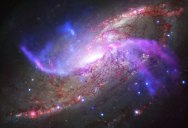Happy 15th Birthday Chandra X-Ray Observatory
Fifteen years ago, NASA’s Chandra X-ray Observatory was launched into space aboard the Space Shuttle Columbia. Since its deployment on July 23, 1999, Chandra has helped revolutionize our understanding of the universe through its unrivaled X-ray vision.
Chandra, one of NASA’s current “Great Observatories,” along with the Hubble Space Telescope and Spitzer Space Telescope, is specially designed to detect X-ray emission from hot and energetic regions of the universe.
With its superb sensitivity and resolution, Chandra has observed objects ranging from the closest planets and comets to the most distant known quasars. It has imaged the remains of exploded stars, or supernova remnants, observed the region around the supermassive black hole at the center of the Milky Way, and discovered black holes across the universe. Chandra also has made a major advance in the study of dark matter by tracing the separation of dark matter from normal matter in collisions between galaxy clusters. It is also contributing to research on the nature of dark energy.
Chandra orbits far above Earth’s X-ray absorbing atmosphere at an altitude up to 139,000 km (86,500 mi), allowing for long observations unobscured by Earth’s shadow. When it was carried into space in 1999, it was the largest satellite ever launched by the shuttle.
To celebrate this incredible instrument’s 15th birthday, the Sifter has compiled 15 standout photos Chandra helped capture over the years. Click here to see the complete Chandra X-ray Observatory gallery on Flickr.
[via NASA]
1. Galactic Pyrotechnics on Display

A galaxy about 23 million light years away is the site of impressive, ongoing fireworks. Rather than paper, powder and fire, this galactic light show involves a giant black hole, shock waves and vast reservoirs of gas. This galactic fireworks display is taking place in NGC 4258, also known as M106, a spiral galaxy like the Milky Way. This galaxy is famous, however, for something that our galaxy doesn’t have – two extra spiral arms that glow in X-ray, optical and radio light. These features, or anomalous arms, are not aligned with the plane of the galaxy, but instead intersect with it.
2. Inside the Flame Nebula

An optical image, from the Digitized Sky Survey, of a large field centered on the Flame Nebula. A comparison with the composite image from Chandra and Spitzer – shown as an overlay – demonstrates how powerful X-ray and infrared images are for studying star forming regions. The central cluster of stars, NGC 2024, is clearly observed in the X-ray and optical images but is not visible in the optical image.
3. Inside the Flame Nebula pt 2

This composite image shows one of the clusters, NGC 2024, which is found in the center of the so-called Flame Nebula about 1,400 light years from Earth. In this image, X-rays from Chandra are seen as purple, while infrared data from NASA’s Spitzer Space Telescope are colored red, green, and blue.
A study of NGC 2024 and the Orion Nebula Cluster, another region where many stars are forming, suggest that the stars on the outskirts of these clusters are older than those in the central regions. This is different from what the simplest idea of star formation predicts, where stars are born first in the center of a collapsing cloud of gas and dust when the density is large enough. Read more here
4. Bright Galaxy Centaurus A

Centaurus A is the fifth brightest galaxy in the sky — making it an ideal target for amateur astronomers — and is famous for the dust lane across its middle and a giant jet blasting away from the supermassive black hole at its center. Cen A is an active galaxy about 12 million light years from Earth.
5. The Fireworks Galaxy

NGC 6946 is a medium-sized, face-on spiral galaxy about 22 million light years away from Earth. In the past century, eight supernovas have been observed to explode in the arms of this galaxy. Chandra observations (purple) have, in fact, revealed three of the oldest supernovas ever detected in X-rays, giving more credence to its nickname of the “Fireworks Galaxy.” This composite image also includes optical data from the Gemini Observatory in red, yellow, and cyan.
6. Glowing Gas in the Milky Way

A region of glowing gas in the Sagittarius arm of the Milky Way galaxy, NGC 3576 is located about 9,000 light years from Earth. Such nebulas present a tableau of the drama of the evolution of massive stars, from the formation in vast dark clouds, their relatively brief (a few million years) lives, and the eventual destruction in supernova explosions. The diffuse X-ray data detected by Chandra (blue) are likely due to the winds from young, massive stars that are blowing throughout the nebula. Optical data from ESO are shown in orange and yellow.
7. A Beautiful End to a Star’s Life

Stars like the Sun can become remarkably photogenic at the end of their life. A good example is NGC 2392, which is located about 4,200 light years from Earth. NGC 2392, nicknamed the “Eskimo Nebula”, is what astronomers call a planetary nebula. This designation, however, is deceiving because planetary nebulas actually have nothing to do with planets. The term is simply a historic relic since these objects looked like planetary disks to astronomers in earlier times looking through small optical telescopes. Read more here.
8. Supernova Remnant W49B

The remnant, called W49B, is about a thousand years old, as seen from Earth, and is at a distance about 26,000 light years away. The supernova explosions that destroy massive stars are generally symmetrical, with the stellar material blasting away more or less evenly in all directions. However, in the W49B supernova, material near the poles of the doomed rotating star was ejected at a much higher speed than material emanating from its equator. Jets shooting away from the star’s poles mainly shaped the supernova explosion and its aftermath. Read more here.
9. Cat’s Eye Nebula

This is an inset from this gorgeous panel image. Main caption: This gallery shows four planetary nebulas from the first systematic survey of such objects in the solar neighborhood made with NASA’s Chandra X-ray Observatory. The planetary nebulas shown here are NGC 6543, also known as the Cat’s Eye, NGC 7662, NGC 7009 and NGC 6826. Read more here.
10. A Surprisingly Bright Superbubblee

This composite image shows a superbubble in the Large Magellanic Cloud (LMC), a small satellite galaxy of the Milky Way located about 160,000 light years from Earth. Many new stars, some of them very massive, are forming in the star cluster NGC 1929, which is embedded in the nebula N44, so named because it is the 44th nebula in a catalog of such objects in the Magellanic Clouds. The massive stars produce intense radiation, expel matter at high speeds, and race through their evolution to explode as supernovas. The winds and supernova shock waves carve out huge cavities called superbubbles in the surrounding gas. Read more here.
11. Elephant Trunk Nebula

When radiation and winds from massive young stars impact clouds of cool gas, they can trigger new generations of stars to form. This is what may be happening in this object known as the Elephant Trunk Nebula (or its official name of IC 1396A).
12. Galaxy NGC 4945

This image provides a view into the central region of a galaxy that is similar in overall appearance to our own Milky Way, but contains a much more active supermassive black hole within the white area near the top. This galaxy, known as NGC 4945, is only about 13 million light years from Earth and is seen edge-on.
13. Supernova Remnant Cassiopeia A

This composite image shows a beautiful X-ray and optical view of Cassiopeia A (Cas A), a supernova remnant located in our Galaxy about 11,000 light years away. These are the remains of a massive star that exploded about 330 years ago, as measured in Earth’s time frame. Read more here.
14. Crab Nebula: Energy for 100,000 Suns

A star’s spectacular death in the constellation Taurus was observed on Earth as the supernova of 1054 A.D. Now, almost a thousand years later, a super dense object — called a neutron star — left behind by the explosion is seen spewing out a blizzard of high-energy particles into the expanding debris field known as the Crab Nebula. X-ray data from Chandra provide significant clues to the workings of this mighty cosmic “generator,” which is producing energy at the rate of 100,000 suns.
15. Tarantula Nebula

30 Doradus, also known as the Tarantula Nebula because its glowing filaments resemble spider legs, is located in the neighboring galaxy called the Large Magellanic Cloud, and is one of the largest star-forming regions located close to the Milky Way. At the center of 30 Doradus, thousands of massive stars are blowing off material and producing intense radiation along with powerful winds. The Chandra X-ray Observatory detects gas that has been heated to millions of degrees by these stellar winds and also by supernova explosions.
If you enjoyed this post, the Sifter
highly recommends:

Sign up to get our BEST stories of the week straight to your inbox.








